When you walk into a live fish store, you’ll normally many types of molly fish with different colors, patterns, tails and fin shapes.
That’s because the term “molly” refers to a whole group of fish, not just one species or variant. All come from the genus Poecilia.
They’re all native to the Americas and are able to adapt to a wide variety of water conditions, from saltwater bays to rainwater canals.
Fish farms and aquarium enthusiasts have selectively bred and hybridized the different species of molly fish over many, many generations to produce the colorful array of varieties you see in stores today.
Mollies, no matter what species or mix of species, are usually broken down into two groups: Shortfin mollies (Poecila sphenops), Sailfin mollies (Poecilia latipinna).
Shortfin Molly Fish Types (Poecilia sphenops)
Shortfin molly types tend to be smaller and don’t have showy dorsal fins
Common Molly
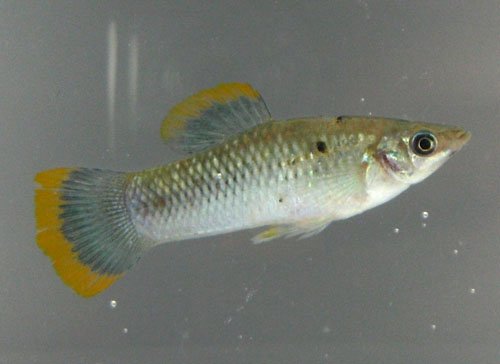
- Size: 3 inches (7.5 centimeters)
- Minimum tank size: 20 gallons (76 liters)
The common molly is the closest to the wild form of Poecilia sphenops, which is the basis for many hybrid varieties, that can be found in the aquarium trade. Their color is quite dull compared to all the flashy captive bred varieties, but they’re super cute little fish nonetheless. Common mollies are a silver color along their backs and have a white belly. The trailing edges of their dorsal and caudal fins are a bright orange color.
Black Molly
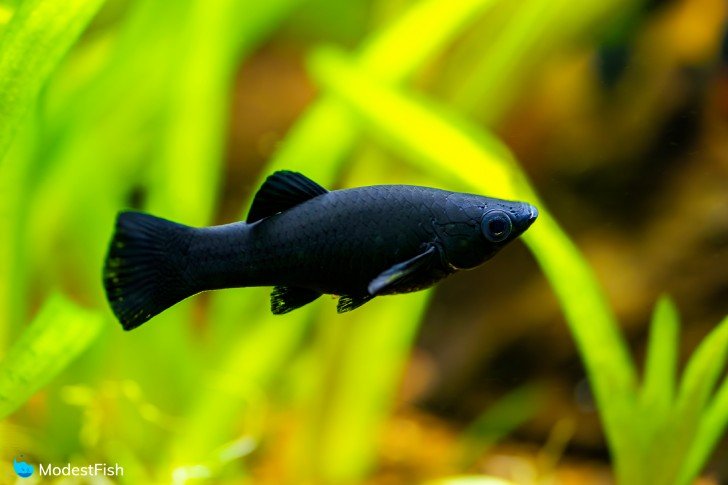
- Size: 3 inches (7.5 centimeters)
- Minimum tank size: 20 gallons (76 liters)
Black mollies are melanistic common mollies, meaning they have an increased amount of the dark pigment melanin in their scales. You see lots of albino fish in the aquarium trade, melanistic fish are the exact opposite; albinos have no melanin while melanistic animals have tons. Black mollies have the same body shape and fins as a common molly, and reach the same adult size, the super dark color is the only real difference.
Golden Molly
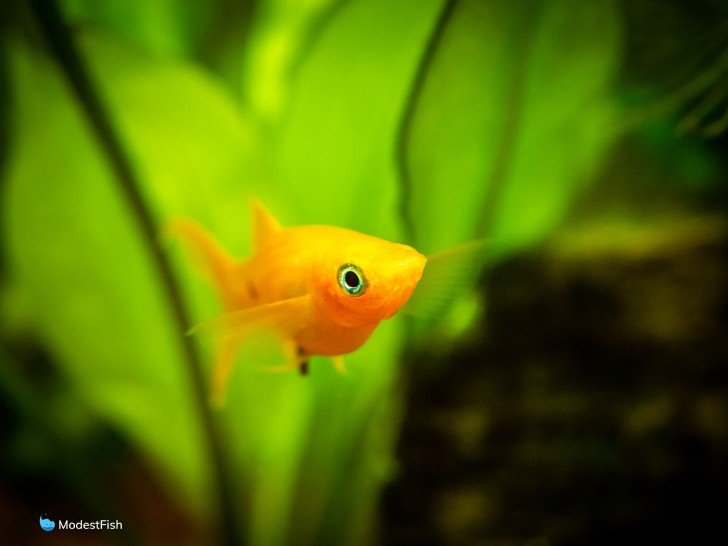
- Size: 5 inches (12.5 centimeters)
- Minimum tank size: 30 gallons (113 liters)
Golden mollies have the same body and fin shape of common and black mollies, but they get substantially bigger. They are a bright golden yellow color. If you look closely, their scales are two-toned. They’re rimmed with an even brighter, almost metallic yellow that shines brightly.
Gold Doubloon Molly
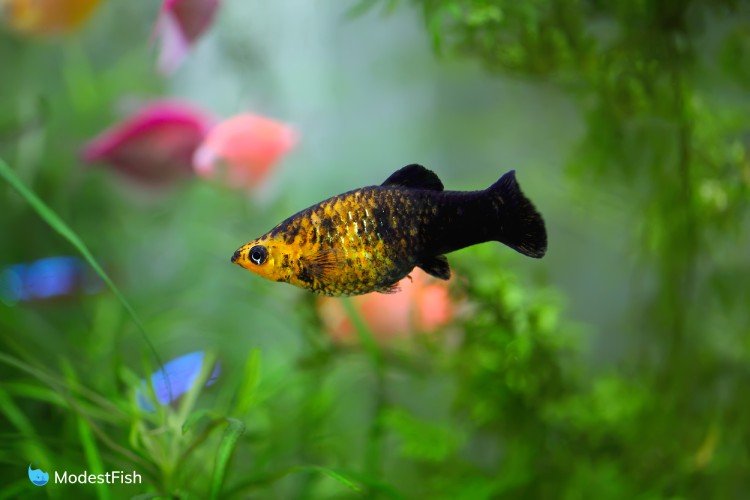
- Size: 5 inches (12.5 centimeters)
- Minimum tank size: 30 gallons (113 liters)
I think this color variation is really cute. Gold doubloon mollies look like a mix of a golden and a black molly. The front half of their bodies is bright yellow-gold and the back half is solid black.
Platinum Lyretail Molly
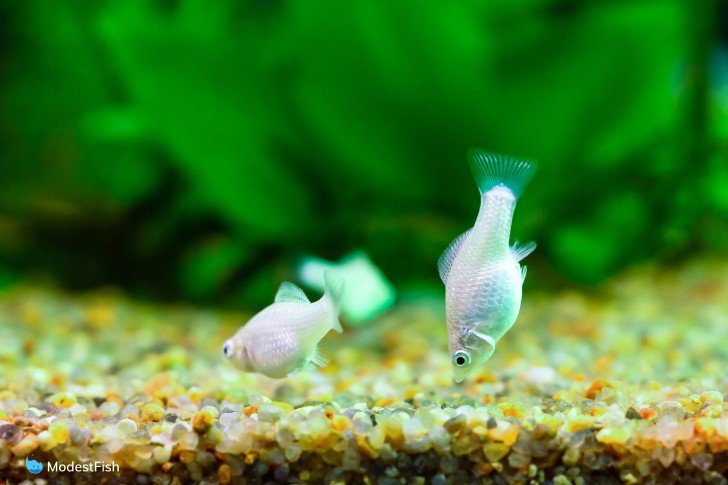
- Size: 5 inches (12.5 centimeters)
- Minimum tank size: 30 gallons (113 liters)
Platinum lyretail mollies are ridiculously beautiful. Their color really makes them stand out. They’re a solid white with tones of shining silver. Lyretail fish have elongated top and bottom rays on their caudal fins. These two trailing spikes resemble a lyre, the small harp that was popular in ancient Greece. So put the gorgeous color, and the fancy tail together, and you get one very striking fish.
Marble Lyretail Molly
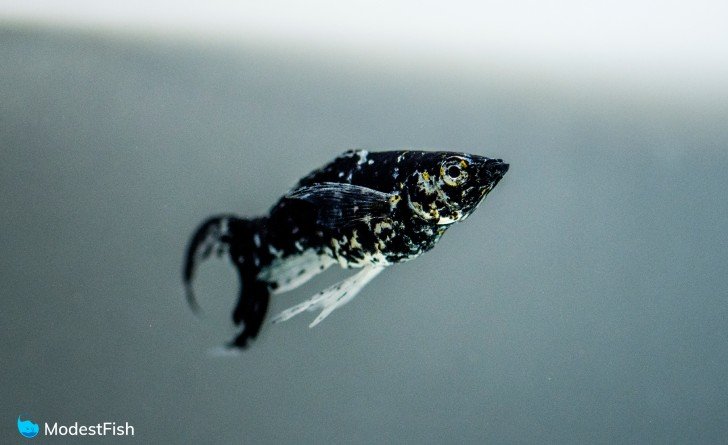
- Size: 5 inches (12.5 centimeters)
- Minimum tank size: 30 gallons (113 liters)
Marble lyretails are covered in splotches of black and platinum all over their bodies. They are easily confused with Dalmatian mollies, but there are some differences. Marble lyretails are a shortfin variety and Dalmatian mollies are sailfins. Also, the speckles on a Dalmatian molly are usually much smaller than those on a marble lyretail.
Sailfin Molly Fish Types (Poecilia latipinna)
Sailfin mollies are larger, around 5 inches (12.5cm), with large flowing dorsal fins.
Black Sailfin Molly
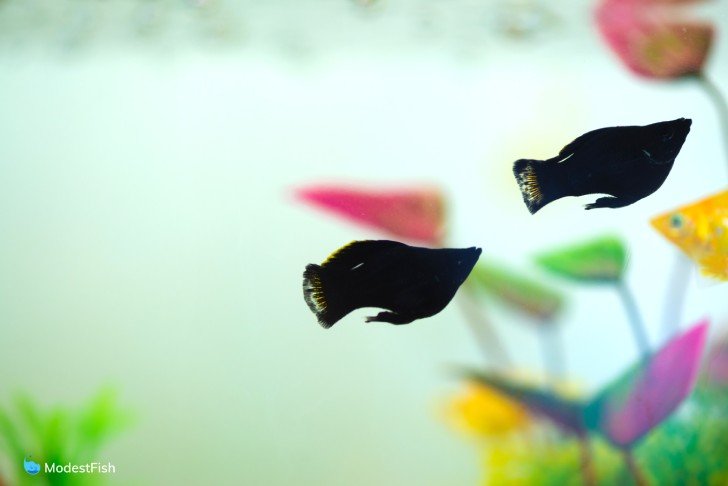
- Size: 5 inches (12.5 centimeters)
- Minimum tank size: 30 gallons (113 liters)
Black sailfin mollies look similar to common black mollies but are much larger. They have the huge dorsal fin characteristic of sailfin mollies and a rounded tail. Some are completely black but others may have white or yellow highlights on their fins. I’ve also seen a few with a bit of orange on their tails. Just like common black mollies, black sailfins are a melanistic color variation.
Black Lyretail Molly
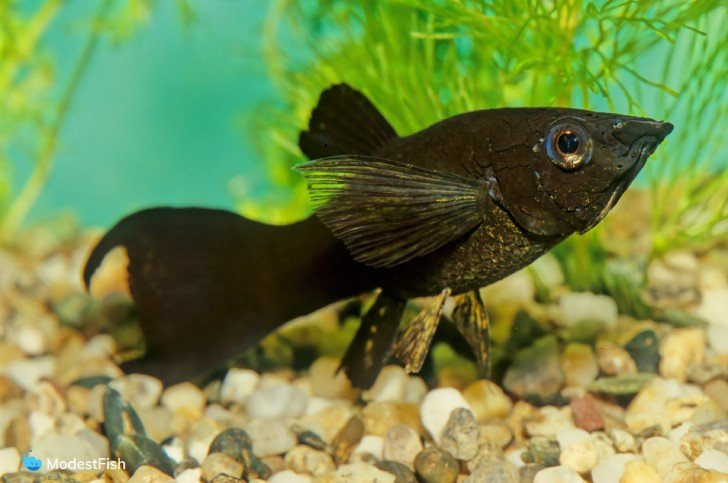
- Size: 5 inches (12.5 centimeters)
- Minimum tank size: 30 gallons (113 liters)
Black lyretails have an interesting mix of characteristics. They have a dorsal fin that is halfway in between a shortfin and sailfin. It’s much larger than a common molly’s dorsal fin, but not nearly as huge as a sailfin’s. Their bodies are shaped more like a common molly but they are much larger fish. Many black lyretails have small white tips on the end of their fins.
Silver Sailfin Molly
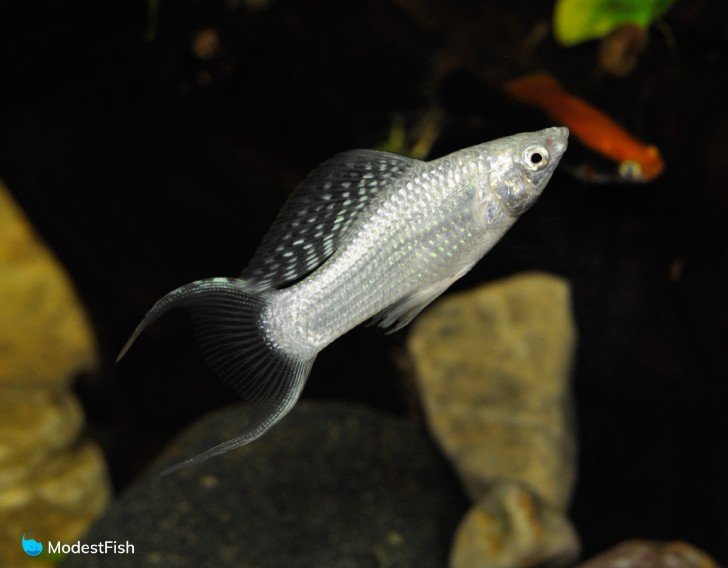
- Size: 5 inches (12.5 centimeters)
- Minimum tank size: 30 gallons (113 liters)
Silver sailfins are the same gorgeous shimmering silver-white color as platinum lyretails. They have a blunt tail and enormous dorsal fins. Their dorsal fins and tails are covered with patterns of iridescent speckles. I love how they have the same ethereal shimmer as a platinum lyretail, but have the giant dorsal fin instead of the fancy tail. Now, if we could just get a platinum lyretail sailfin, all my dreams would come true.
Red Sunset Sailfin Molly
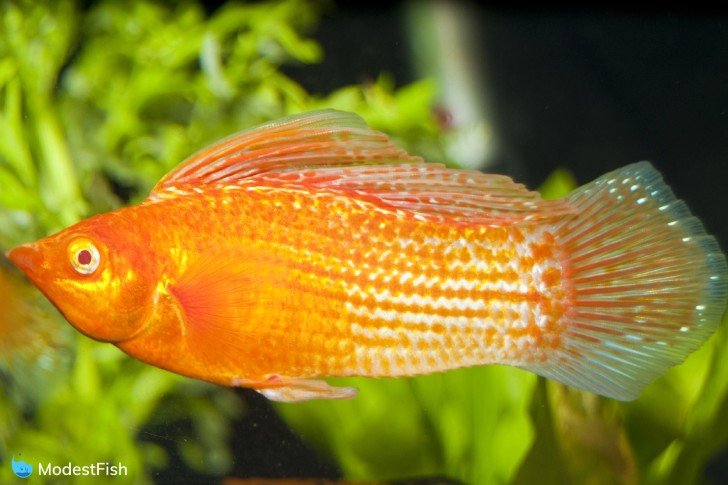
- Size: 5 inches (12.5 centimeters)
- Minimum tank size: 30 gallons (113 liters)
Red sunset mollies are really eye-catching. They’re a bright, bright orange-red color with rows of metallic blue speckles. This pattern extends all the way up their huge dorsal fins as well. Simply ridiculously gorgeous.
Harlequin Sailfin Molly

- Size: 5 inches (12.5 centimeters)
- Minimum tank size: 30 gallons (113 liters)
Harlequin sailfins look very similar to red sunset mollies. They have the same red-orange body color and huge dorsal fin. But the harlequin has splotches and speckles of black all over its body and fins.
Creamsicle Lyretail Sailfin Molly
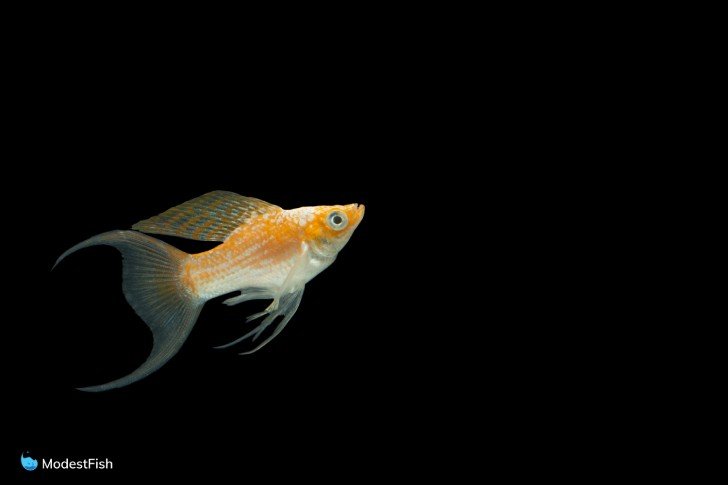
- Size: 5 inches (12.5 centimeters)
- Minimum tank size: 30 gallons (113 liters)
This color variation is another of my favorites. Creamsicle mollies are a light orange color, sometimes with a white belly. They often have rows of silver speckles along their bodies and rows of silver and orange speckles on their tails and fins. To me, the combination of the orange and silver is very striking. This is another species with the ginormous dorsal fin that’s covered in the same eye-catching pattern as the body.
Calico Creamsicle Sailfin Molly
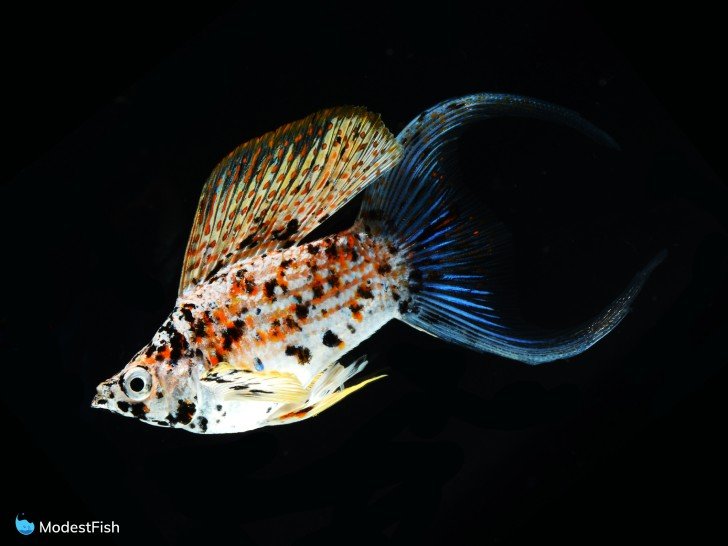
- Size: 5 inches (12.5 centimeters)
- Minimum tank size: 30 gallons (113 liters)
The calico creamsicle has the same color pattern as a regular creamsicle, but the speckles are black instead of silver.
Dalmatian Lyretail Molly
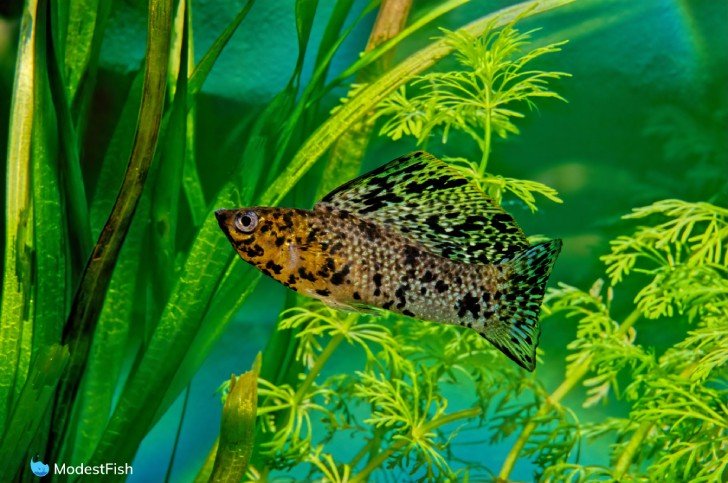
- Size: 5 inches (12.5 centimeters)
- Minimum tank size: 30 gallons (113 liters)
Dalmatian lyretail mollies are covered in small black and silver speckles. They look similar to marbled mollies but there are some differences. The spots on a Dalmation molly are much smaller than on a marble molly. Also, the Dalmatian molly gets up to 5 inches long while marble mollies max out at about 3 inches (7.5 centimeters).
A Note on Balloon Mollies
You may also run across mollies with what look like huge swollen abdomens that are sold as “balloon mollies” in life fish stores.
They look like you took a regular molly and then overinflated it, like in a cartoon.
Balloon mollies don’t actually have bigger stomachs than regular mollies. The fact is, they have deformed, curved spines that push their abdomens out.
There is quite a bit of controversy when it comes to balloon fish (there are also balloon guppies).
Some think that there’s nothing wrong with balloon mollies, they find them cute, and the fish seem to be doing just fine in their tank.
Others point out that balloon mollies could be in constant pain because of their deformed spines and breeders are perpetuating this defect simply because people like the look of it.
I don’t have definitive proof that balloon mollies are in constant pain, or that they’re not. I do know that lots of aquarists report that balloon mollies don’t live as long as other varieties of mollies.
And I do know that fish with compressed abdomens are more susceptible to issues like constipation, which can be deadly to fish.
So, I personally do not recommend them. I don’t want to take a chance on a fish that could be in discomfort all the time and might die young.
For myself, I’d rather err on the side of caution and not support the kind of captive breeding that perpetuates something that is technically a deformity.
Which Type of Molly Fish Is Right For You?
There are probably some varieties of molly out there that I missed, but I gave it the old college try.
I love how there are different varieties of mollies with all the various colors, patterns and fin shapes out there.
Just remember that the sailfin varieties get pretty big. You’ll need at least a 30 gallon tank and more like a 40 gallon or 50 gallon (151-190 liters) if you want to have multiple fish.
Mollies are extremely active and need a lot of space. Plus, they’re big eaters so they produce a lot of waste. All that adds up to the need for the biggest tank possible.
If you keep males and females, keep 2-3 females per 1 male. And remember that they are livebearers that will produce babies every month.
Click here for more information on molly fish general care.
I wish you and your fish the very best!
